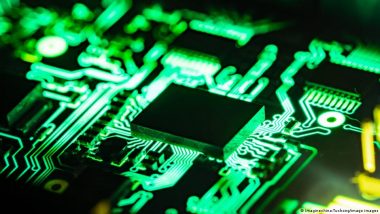Researchers have showcased the first functional graphene semiconductor. The discovery could change computing and electronics forever.Scientists have made a breakthrough in electronics, creating the world's first functional semiconductor made from graphene — a material known for being tough, flexible, light, and with a high resistance.
Their discovery comes at a time when silicon, the material from which nearly all modern electronics are made, is reaching its limit.
Also Read | The Dream of an Artificial Heart: How Close Are We?.
Scientists have been racing to develop graphene semiconductors because of their superior speed and energy efficiency compared to silicon.
The study, published in Natureon January 3, demonstrates a functional graphene semiconductor which is suitable for use in nanoelectronics.
The authors say the discovery could mark a major step towards the next generation of computing and throws open the doors to a new way of building electronics.
"We don't know where this will end but we know we're opening the door for a major paradigm shift in electronics. Graphene is the next step. Who knows what the next steps are after that, but there's a good chance graphene could take over be the paradigm for the next fifty years," said lead author Walt de Heer from the US' Georgia Institute of Technology in a press release.
Silicon semiconductors are reaching their limit
Classical computers like the chip in your phone or laptop use electricity flowing through silicon switches to represent ones and zeros — also known as bits.
"Semiconductors are essential to allow all computers to function. They allow us to create tiny switches which can be turned on and off to allow the flow of electricity. It is this electricity flowing through electrical circuits that allows computers to perform calculations," said Sarah Haigh, Professor of Materials National Graphene Institute, University of Manchester, UK.
We use silicon semiconductors every time we use a credit card, start the car, open doors on buses and trains, and of course use a smartphone or laptop.
But silicon semiconductors have their limitations, which led scientists to search for a new material.
"Silicon electronics require a fairly large amount of power and energy, including energy needed to cool the electronics when energy is emitted as heat," Haigh told DW.
Graphene: wonder material
One option was graphene. Graphene is a single sheet of carbon atoms — a 2D material held together by the strongest chemical bonds known. These carbons are arranged in tessellated hexagons, much like honeycomb.
It is an incredibly strong material — about 200 times stronger than steel. It's so strong you can hold up a football with just one atomic layer of graphene.
Graphene is also incredibly flexible, making it ideal for use in electrical devices and batteries, or even printed on to glass, plastics, or fabrics.
But its potential to be used as a faster and more energy efficient semiconductor excites scientists the most.
"The possibility to retain graphene's exceptional speed as well as the efficiency of the conduction of electrons without requiring large amounts of energy, offers huge potential for it to be used to create "beyond silicon" electronics where computers are faster and use less energy to run," said Haigh.
First functional graphene superconductor
Graphene had major drawbacks which prevented its use in electronics. One major problem is known as "band gap problem".
"Scientists in the field have been trying to realize the exceptional conductivity of graphene in electronic circuits for over a decade," said Haigh.
The band gap is a crucial electronic property that allows semiconductors to switch on and off. Graphene didn't have a band gap — until now.
De Heer's team figured out how to grow graphene on special silicone carbide chips. The research took ten years, where the team refined materials and altered graphene's chemical properties until they achieved the perfect structure.
Finally, the graphene acted like a high-quality semiconductor that rivalled silicon.
"The good thing about graphene is, not only can you make things smaller and faster and with less heat dissipation, you're actually using properties of electrons that are not accessible in silicon. So this is really a paradigm shift — it's a different way of doing electronics," said de Heer.
Faster, more energy efficient electronics
Experts say the innovation holds huge potential for the electronics industry. For one thing, it could allow us to create new graphene semiconductors which are much more powerful, but use less energy than their silicon counterparts.
"Graphene electronics are more efficient because they can require less energy to switch on and off. They also allow electrons to flow without creating a lot of unwanted heat that has to be cooled with fans (requiring energy)," said Haigh.
"This would mean phones could last for weeks without running out of battery, reduce energy consumption in all parts of our lives, reducing costs and the pollution from fossil fuels," Haigh added.
De Heer said his discovery could change the future of electronics.
For one, the new graphene superconductors could accelerate the development quantum computing technologies.
Quantum computers can solve problems in seconds that would take ordinary super computers millennia to do, but they're still in development.
Experts say graphene semiconductors could help overcome the many challengesof creating quantum computers.
Edited by Michaela Cavanagh.
(The above story first appeared on LatestLY on Jan 04, 2024 09:20 PM IST. For more news and updates on politics, world, sports, entertainment and lifestyle, log on to our website latestly.com).













 Quickly
Quickly





















